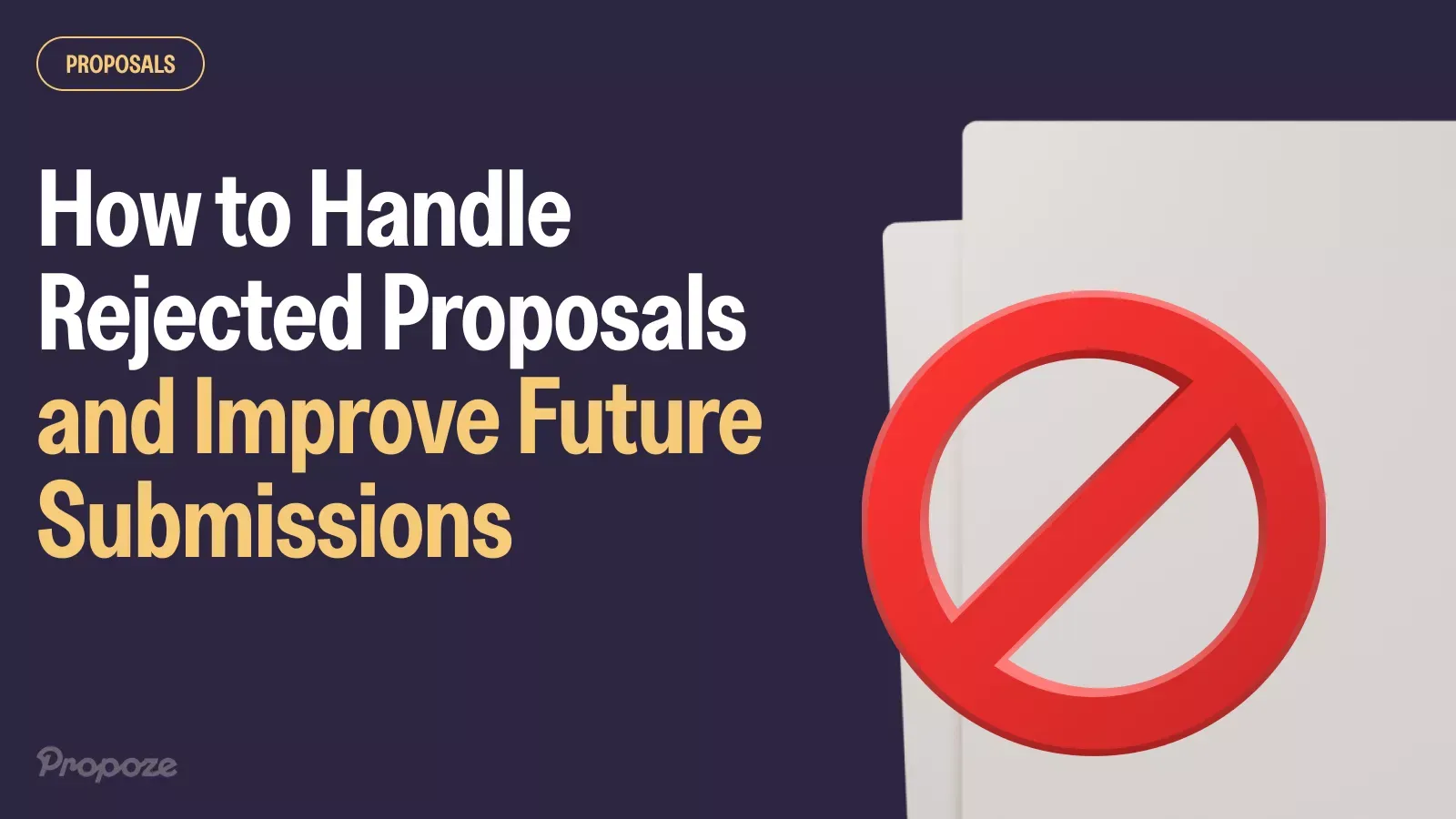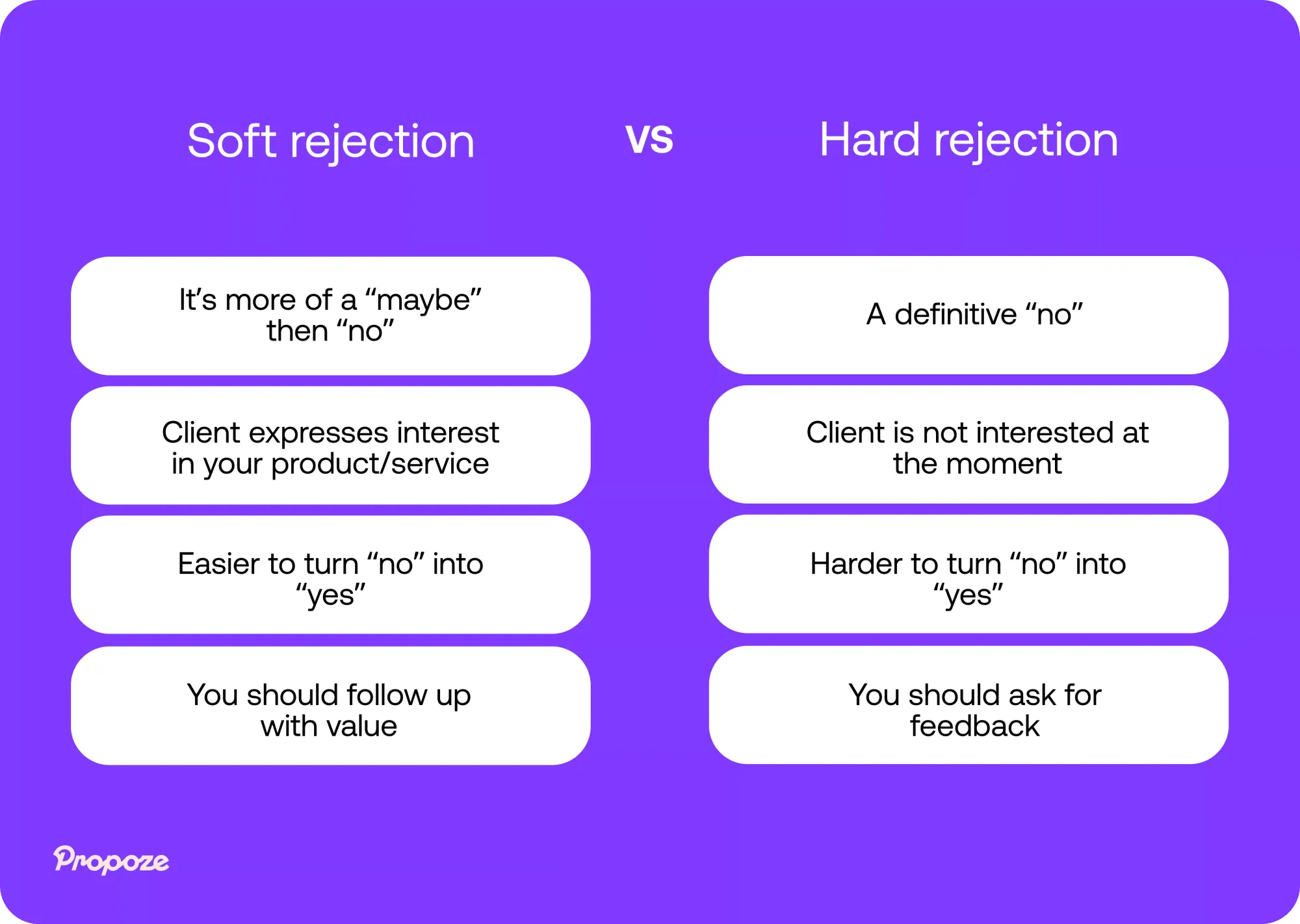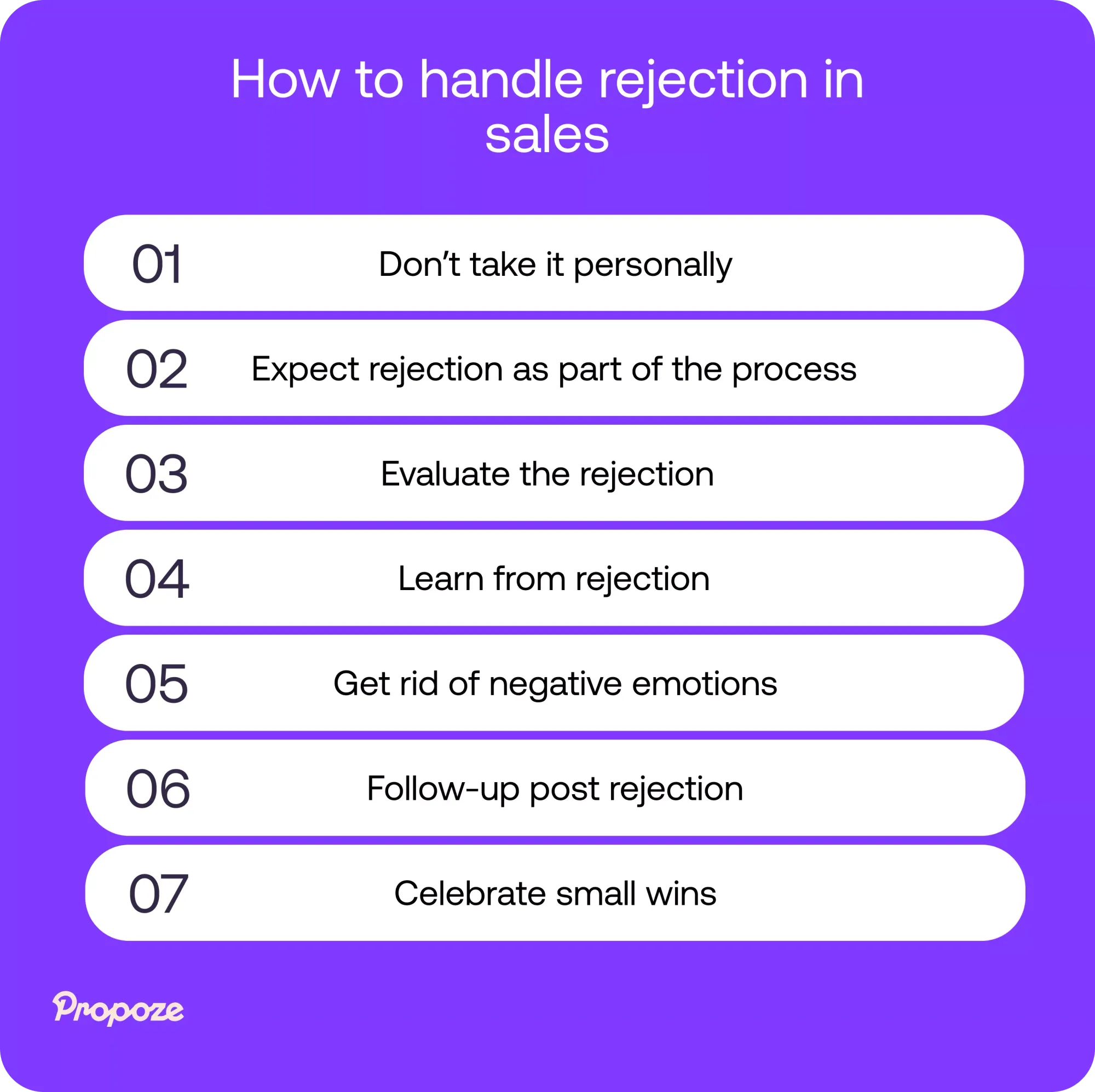How to Handle Sales Rejection: Ultimate Guide for B2B Sales
Discover practical strategies to turn rejection into opportunity and build resilience in B2B sales, with actionable tips to boost your close rate.
— Propoze

Handling sales rejection is a skill every B2B salesperson needs to master.
Whether it’s a soft “no” or a hard rejection, knowing how to respond can make all the difference.
One thing’s for sure — getting rejected can be tough, but frequent rejection is also inevitable in sales.
The good news? Rejection doesn’t have to derail your confidence or success. Embracing a growth mindset can help you view rejection as a learning opportunity, allowing you to improve your skills and adapt your approach.
Let’s explore how you can handle rejection, stay resilient, and ultimately turn those “no’s” into future opportunities!
Different forms of sales rejections – soft and hard rejection
Rejection is part of sales, but not all rejections are equal.
In B2B sales, you’ll typically face two types — soft and hard rejections.
1) Soft rejection
This is the “maybe” zone — “We need more time” or “Let’s revisit this later.”
It’s frustrating because it’s not a clear "no," but it’s also an opportunity. It means there’s interest, but something’s holding them back. Maybe it’s budget, timing, or internal approvals.
Think of soft rejections as a pause button in the sales conversation — not a dead end.
How to handle soft rejections?
When you hear a soft rejection, don’t disappear. Instead, stay top of mind by following up with value.
Send relevant case studies, or share industry insights that could nudge them toward a decision. The key is to be persistent without being pushy — let them know you’re there when they’re ready.
Timing is crucial here. Waiting too long might cause them to forget about you, while pushing too soon could feel intrusive. Find that balance.
2) Hard rejection
Ouch, the dreaded hard “no.” It sounds like, “We’re not interested,” or worse, “We’ve decided to go with someone else.”
It stings, but it’s not the end of the road — at least not always. A hard rejection is definitive, but that doesn’t mean it’s forever.
Remember, just because they said no today doesn’t mean their needs won’t change tomorrow.
How to handle hard rejections?
Take hard rejections in stride, and don’t take rejection personally.
Thank the prospect for their time, and maintain a positive, professional tone. A graceful exit leaves the door open for future business.
Ask for feedback — why did they choose another solution? Use their insights to improve your future pitches. And don’t give up entirely. Circumstances change.
Check-in down the line, not to push for another sale, but to show you’re still thinking about how you can help them solve their challenges. You’ll stay on their radar without the pressure.
In any case, it all sounds simple when we say it like that. But in reality, there’s a lot more to know when it comes to handling rejections in sales.

How to handle rejection in sales?
Rejection is part of the sales process, but it doesn’t have to be a setback. In fact, how you handle rejection can define your success in B2B sales.
Instead of letting a “no” crush your confidence, see it as a moment to learn, adapt, and build resilience. By mastering the art of handling rejection, you can maintain momentum and stay motivated, even in the toughest situations.
Here’s a comprehensive list of strategies to handle rejection, with actionable tips to help you bounce back and thrive.
1) Don’t take it personally
Sales rejection can sting, but for a sales rep, it’s rarely a reflection of you. Most of the time, it’s about factors like timing, budget, or fit — not your skills.
So, instead of internalizing the “no,” use it as a chance to grow. Think of each rejection as part of the bigger picture, a small hurdle in a long-term journey toward success.
After a rejection, take a moment to reflect — not on what went wrong with you, but on how you can adjust your approach next time.
Stay positive, and remember that resilience is key in sales. One “no” today doesn’t define your potential tomorrow.
2) Expect rejection as part of the process
Rejection isn’t just common in B2B sales — it’s inevitable. No matter how polished your pitch is or how perfect the fit may seem, you will hear “no” more often than “yes.”
But here’s the key: instead of dreading rejection, expect it. It’s part of the journey.
By normalizing rejection, you can reduce the emotional toll it takes. Knowing that a “no” is just one step toward the next opportunity helps you stay resilient. Treat each rejection as a learning moment, not a roadblock.
Here’s a pro tip for you.
Automating follow-ups after rejection helps take the emotional edge off. Instead of manually tracking every lead and feeling the weight of each rejection, you can set up a system that re-engages prospects at the right time. This way, you remain productive and focused, without dwelling on the setbacks.
Keep your eyes on the bigger picture—rejection today often plants the seed for future success and achieving your sales goals.
3) Evaluate the rejection
Every rejection is a chance to improve, but first, you must understand why it happened.
Don’t be afraid to ask the client for feedback — whether it’s through a quick email or a polite conversation. Learning what didn’t resonate, whether it was pricing, timing, or product fit, gives you the information you need to refine your future approach and address the prospect's objections professionally.
Here’s a great idea.
Instead of guessing why things fell through, directly ask, “What could we have done differently?” This feedback is invaluable for sharpening your strategy and improving your sales pitch moving forward.

4) Learn from rejection
Rejection is one of the best teachers in sales, but only if you take the time to learn from it. After every “no,” analyze what happened.
Was it a matter of price? Timing? Was the product not a good fit for their needs?
Keep track of the reasons behind rejections. Over time, you’ll notice recurring themes — maybe pricing is a consistent concern or your proposal isn’t addressing key pain points. This insight is crucial for refining your sales skills and making adjustments.
5) Get rid of negative emotions
Self confidence can be significantly impacted by rejection, stirring up negative emotions — frustration, self-doubt, or even burnout.
The key is to reframe those negative thoughts into opportunities for growth. Instead of seeing rejection as a failure, treat it as a valuable lesson.
What can you learn? How can it improve your approach for the next prospect?
Try automating repetitive rejection processes. Set up systems that handle follow-ups or reminders, so you can stay productive and keep moving forward without getting bogged down emotionally.
Keep your mindset positive, and focus on the bigger picture.
6) Follow-up post rejection
Rejection today doesn’t mean the door is closed forever — this is where strategic follow-ups shine.
The timing is crucial. Wait too long, and the prospect may forget about you. Follow up too soon, and you risk coming off as pushy. Aim for a balanced approach, waiting a week or two, depending on the situation.
When following up, focus on providing value — share helpful insights, updates, or offer new solutions that address their initial concerns.
The best advice we can give you is — use automation tools to set reminders for follow-ups at the right times to make sure you don’t miss opportunities while keeping the pressure off.
This way, you maintain momentum without feeling the stress of managing each follow-up manually.
By integrating automation and offering value in each follow-up, you'll stay top of mind without being overbearing, turning a past rejection into a potential future opportunity.
7) Celebrate small wins
In sales, it’s easy to focus on the big deals, but for a sales professional, the small wins — even landing a promising meeting or moving a prospect further along — deserve to be celebrated.
Acknowledging these victories keeps morale high and fuels long-term motivation. It’s about recognizing progress, not just the end goal.
Make it a habit to pause and celebrate each step forward, whether it’s closing a small deal or receiving positive feedback from a prospect. Share these wins with your team to create an atmosphere of success.
Testimonials and case studies can be a great reminder of past successes, reinforcing that progress is being made.

How do you respond to a sales decline?
Responding to a sales decline effectively means keeping the relationship open and maintaining professionalism.
It’s not the end of the road, but a chance to refine your approach and lay the groundwork for future opportunities.
Here’s what to do.
1) Ask for feedback
After a sales rejection, seeking constructive feedback can be super beneficial. Politely ask the prospect why they didn’t move forward with your proposal.
This helps you understand where you can improve and refine your future pitches.
A follow-up email could say: “Thank you for considering our proposal. To help us improve, we’d appreciate any feedback on why our offer didn’t align with your needs. Your insights are invaluable as we strive to better serve clients like you.”
Feedback offers a window into client expectations, allowing you to adjust and succeed in future opportunities.
2) Stay professional and gracious
Even after a rejection, maintaining professionalism leaves a positive impression and can lead to future opportunities.
Respond graciously, thanking the prospect for their time and consideration, while avoiding any hard feelings or pressure to reconsider. This shows you respect their decision, and it’s a reflection of your character and your brand.
Keep communication consistent and professional by setting up automated follow-ups that remain polite, informative, and relevant. This ensures you stay on their radar without losing that personal, respectful touch — and gives you a chance to turn that "no" into a "yes" somewhere down the line.
Common sales objections and how to respond to them
Sales objections are a natural part of the process, especially in B2B sales. A sales manager can play a crucial role in addressing these objections by offering guidance and resources to enhance your approach.
But instead of seeing them as obstacles, think of them as opportunities to understand your prospects better. Whether they’re concerned about cost, timing, or working with other vendors, objections give you a chance to clarify and provide tailored solutions that meet their needs.
Here are the 3 most common sales objections you’ll face.
1) "Your product/service is too expensive."
When prospects say, "It's too expensive," they may not fully understand the value of your product.
Instead of lowering your price, emphasize the ROI they’ll receive. Highlight how your solution saves them time, boosts efficiency, or directly addresses their pain points.
If budget is still a concern, consider offering tiered pricing options. This gives them flexibility while still showcasing the core benefits of your solution.
You can craft personalized, budget-conscious packages using custom proposals, ensuring they see the value at every price point.
Additionally, tie in long-term benefits, showing how initial investments pay off over time. This approach makes it clear that your product isn’t just an expense, but a strategic investment.
2) "I'm not interested."
When a prospect says they’re not interested, it often means your offer didn’t resonate with their immediate needs.
Instead of closing the door, reposition your solution by focusing on their long-term goals or highlighting different benefits they may not have considered. For example, emphasize how your product can solve challenges they’re likely to face in the future.
Here's a smart tip!
Track their engagement using analytics to see which sections of your proposals grab their attention. This insight helps you craft future proposals that better align with their priorities.
3) "We’re already working with another vendor."
When a prospect tells you they’re already partnered with another vendor, it’s tempting to walk away. But this is your chance to differentiate your solution.
Instead of competing on price or similar features, focus on what sets you apart — whether it's a unique feature, better customer service, or a more tailored solution.
By using custom proposals, you can emphasize these differentiators clearly. Highlight what makes your product stand out and how it can complement or exceed what they’re currently using.

Best practices for overcoming rejection in B2B sales
In B2B sales, rejection is part of the journey, but how you handle it makes all the difference.
Here are some key strategies to manage rejection effectively.
To handle rejection effectively, it’s crucial to keep your sales pipeline full.
When you have multiple opportunities in play, no single rejection feels like the end of the road. Think of your pipeline as a safety net—it provides consistency and keeps momentum going.
Having a steady stream of potential clients helps you stay focused on the big picture. Regularly nurture leads at different stages, ensuring that even when one deal falls through, others are moving forward.
You can even schedule regular pipeline reviews to assess which leads need attention. This helps prevent your pipeline from going stale and ensures you’re always working toward new opportunities.
Having a pipeline that’s consistently moving forward not only shields you from the effects of rejection but also creates a healthier, more dynamic sales process for your sales team.
One of the most effective ways to overcome rejection is by refining your proposals based on the feedback you receive.
If a prospect cited price, timing, or product fit as the reason for saying "no," take that insight to customize your future offers. Tailor each proposal to directly address the client’s specific concerns, and showcase how your solution aligns with their needs.
Practical Steps:
- Review feedback and identify patterns.
- Adjust pricing or product features to offer tiered solutions.
- Make proposals more personal, using the client’s language and business goals to reflect their challenges.
When price becomes the main objection, it’s easy to get caught up in lowering costs to win the deal. However, competing solely on price often devalues your offering and leads to diminishing returns.
Instead, shift the conversation to focus on the value your solution brings to the table.
Talk about how your product or service can solve critical problems — whether it’s increasing productivity, reducing long-term costs, or providing expertise they won’t find elsewhere.
Tailor your proposal to the prospect’s specific challenges, showing how your solution addresses their needs more efficiently than cheaper alternatives.
For example, instead of discussing pricing alone, break down how your solution will provide a clear ROI. Demonstrate how investing in your product today can yield long-term savings, streamline processes, or even increase their revenue.
Tools to reduce sales rejection and improve proposals
Reducing sales rejections often comes down to having the right tools at your disposal.
By automating key processes — like creating proposals, sending follow-ups, and tracking client engagement — you can improve your workflow and make smarter decisions.
Creating proposals manually can be time-consuming and prone to errors. Proposal automation lets you quickly generate professional, consistent proposals, tailored to each client.
With pre-built templates and dynamic data inputs, your proposals are always accurate and personalized.
The best part? It dramatically speeds up turnaround times, helping you respond to opportunities faster and close deals more efficiently.
Wouldn’t it be great to know exactly how prospects engage with your proposals?
By using feedback loops and analytics, you can track which sections they spend the most time on, and where their interest drops. These insights help you refine your messaging, adjust pricing, and make smarter decisions.
Over time, this data-driven approach leads to fewer rejections, as you can anticipate objections and deliver proposals that directly address their needs.
Sales professionals know that staying connected with prospects is critical in sales, and tracking how they interact with your proposals gives you a competitive edge.
With client communication tracking, you can monitor when emails are opened, which sections are reviewed, and what parts are revisited.
This data allows you to fine-tune follow-ups, address potential concerns early, and prioritize leads who show strong engagement — ultimately boosting your chances of closing the deal.
Turn every rejection into an opportunity
Rejection happens, but it doesn’t have to be the end of the road. Each "no" is a chance to tweak your approach and get even better for the next opportunity.
With Propoze, creating and customizing proposals is simple and efficient, helping you respond quicker and with more precision. By making your workflow smoother, you’ll be ready to turn those rejections into future wins.
Want to see how? Try Propoze with a free trial today!
